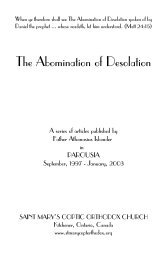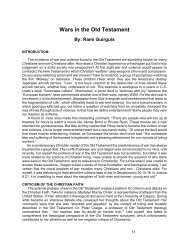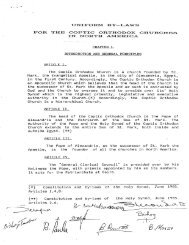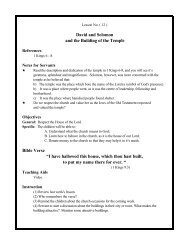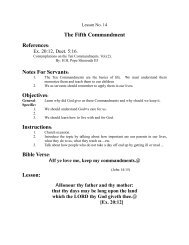Creation - St. Marys Coptic Orthodox Church
Creation - St. Marys Coptic Orthodox Church
Creation - St. Marys Coptic Orthodox Church
Create successful ePaper yourself
Turn your PDF publications into a flip-book with our unique Google optimized e-Paper software.
In many respects this is a classic formulation of how Darwin<br />
viewed evolution: every species consists of individuals that show<br />
considerable variations. Under certain environmental conditions<br />
particular variations will be most advantageous. Natural selection<br />
weeds out the unadapted and the best-adapted survive. These<br />
variations become dominant in the species and so it evolves. In<br />
the case of giraffes, times of drought and arid conditions give an<br />
advantage to those animals that can out-compete others by<br />
reaching the higher, untouched leaves. They form the ancestral<br />
stock of the animals that evolve into giraffes.<br />
Interestingly, Darwin believed in the “inherited effects of the<br />
increased use of parts”. ... Darwin felt that this was key to explain<br />
giraffe evolution; otherwise there is no guarantee that longer<br />
features in one generation will have an effect on subsequent<br />
ones. But this view of the inheritance of acquired characteristics<br />
is rejected by mainstream Darwinists today. Various scientists<br />
have noticed that this elegant picture of giraffe evolution<br />
dissolves under closer scrutiny. Here are a few examples of my<br />
and their objections:<br />
1) Since the taller, longer-necked, evolving giraffe ancestors were<br />
also larger and heavier, they would need more food than the<br />
animals they're competing with. Wouldn't this counterbalance<br />
their advantage in times of dearth? Would they really have any<br />
advantage over smaller members of the same and other species?<br />
Moreover, it is absurd to assume that only the leaves on high<br />
branches were available to the giraffe during a drought. Had this<br />
been the case, then the multitude of browsing and grazing<br />
antelope species in Africa would all have gone extinct (or never<br />
evolved in the first place). So, even without growing taller, the<br />
giraffe ancestor could have competed on even terms for those<br />
lower leaves.<br />
2) Male giraffes today are up to one meter taller than female<br />
giraffes; newborn and young giraffes are much smaller. The<br />
moment this sexual dimorphism manifested in the evolution of<br />
the giraffe, it would have been the males that could have reached<br />
the higher branches. The females and young animals would have<br />
57




